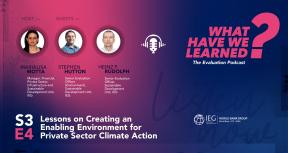Listen on: Apple Podcasts, or Spotify.
Climate change caused by the emission of greenhouse gases (GHGs) is an urgent challenge, and the poorest communities around the world are likely to be hit the hardest by its worsening impact. Achieving net-zero emissions will require an annual financing of USD 5 trillion by 2030, and this level needs to be sustained until 2050.
The private sector is a critical partner for countries in addressing this financing gap and confronting fighting climate change and its impact. The private sector can support mitigation efforts by reducing greenhouse emissions in its operations using or developing technologies and processes that have low or zero emissions. It can support adaptation efforts by building climate resilience into its operations and investments. Financing from the private sector will also be critical for meeting the needs for global finance flows.
But private sector participation and financing has been very low on climate issues. One reason for this is that most countries lack a conducive enabling environment for the private sector to engage in climate action. The Independent Evaluation Group (IEG) recently published a report that offers lessons from Bank Group experience in improving the enabling environment in countries towards fostering private sector climate action.
In this episode, Stephen Hutton and Heinz P. Rudolph, Senior Evaluators and co-authors of the above IEG report, join Marialisa Motta, manager in the Finance, Private Sector, Infrastructure, and Sustainable Development department of IEG. They discuss how countries can better engage the private sector towards addressing climate change and its impact and the role that the World Bank and other international organizations play in this.
TRANSCRIPT
Generating private sector climate action at scale needed to achieve the world's climate goals will require scalable solutions. The emergence and deepening of new sectors that apply low-carbon or resilient approaches are critical for achieving climate change goals.”
Marialisa Motta:
Climate change is an urgent challenge and the poorest communities around the world are likely to be hit the hardest by it. The private sector is a critical partner for countries in preventing and coping with climate change. The private sector can support mitigation efforts by developing technologies and processes that have low or zero emissions. It can also support adaptation efforts by building climate resilience into its operations and investments. The private sector will also be critical for meeting the needs for global finance flows to address climate change. But at the same time, private sector participation in and financing for climate action has been very low in developing countries.
One reason for this is that most developing countries lack a conducive, enabling environment for the private sector to engage in climate action. How can countries create the right enabling environment to unleash the creativity and finance of the private sector to address the challenge of climate change? What role can the World Bank Group and other international organizations play in helping countries achieve this goal?
Welcome to What Have We Learned? The Evaluation Podcast. I'm your host, Marialisa Motta, a manager in the finance private sector infrastructure and sustainable development department of the World Bank Group's independent evaluation arm, IEG. In this episode, we'll try to answer some of the questions that I mentioned by looking at the lessons captured in a recent IEG report titled Creating an Enabling Environment for Private Sector Climate Action: An Evaluation of World Bank Group's Support. For this, I'm joined today by Stephen Hutton and Heinz Rudolph, the co-authors of the IEG report and senior evaluation officers in IEG.
Welcome Stephen and Heinz to What Have We Learned? Let me begin with you, Stephen. What are some of the challenges and constraints that the private sector faces in engaging on climate action?
Marialisa Motta:
Let me begin with you, Stephen. What are some of the challenges and constraints that the private sector faces in engaging on climate action?
Stephen Hutton:
So, the private sector has many constraints in engaging on climate. Some of these are the high-level macroeconomic context and the broad private sector enabling environment that apply across all sectors. Others are lower level and intervention specific. But in between is what we term the enabling environment for private sector climate action. This is the set of policies, incentives, standards, information, and institutions that facilitate the private sector to invest or behave in ways that reduce greenhouse gas emissions or adapt to climate change.
Marialisa Motta:
Thank you, Stephen. Tell me, what does a good climate change enabling environment look like? Which type of environment supports private sector climate action?
Stephen Hutton:
So, one of the things the evaluation has done is to develop a framework of climate change enabling environment, which identifies the types of constraints to private sector action and the types of interventions that can help to address those constraints. The framework has three broad buckets that are needed for markets to operate. First, there are price and non-price regulations that affect incentives to undertake private sector climate action. There are economy-wide price-setting measures such as carbon taxes and addressing explicit or implicit subsidies for fossil fuels. There are sector-specific incentives to encourage investments in particular climate sectors. These can include tax incentives and other subsidies for renewable energy and green buildings, or payments for ecosystem services for agroforestry operations. And there are ways to discourage emission producing or non-resilient activities through non-price measures by enacting regulations, such as on pollution or issuing energy efficiency mandates, fuel standards, or resilient building codes.
Second, there are efforts to provide the information needed to markets to make climate-related investment decisions, especially for climate change related sectors that may be new or unfamiliar to investors. Data, including the mapping of climate hazards, voluntary standards and certification of green products, and facilitation of climate-related research and development can support investment decisions in climate change related sectors.
Considering the increasing investor appetite for green investments, government actions that help investors identify sectors and activities that contribute to climate action can guide investment decisions, including through green taxonomies and sustainable finance regulations that mandate disclosure. Additionally, interventions that help countries to identify pipelines of climate-related projects can foster investment, such as through power sector plans that signal there will be investible opportunities. And third, there is the need to manage risks and build institutional capacity. Most government institutions related to building public infrastructure are generally designed with the purpose of executing their budget and may not have the institutional capacity for designing and managing contracts with private sector counterparts.
The private sector can be reluctant to engage with such public sector institutions. Institutional capacity of the public sector is therefore key for developing effective contracts and building credibility with private sector counterparts. Large climate-related investments, especially those including infrastructure, involve significant capital and long payback periods. This may expose private investors to a range of risks, including those related to counterparty, credit, demand, foreign exchange financing operations and force majeure among others. Mitigating or transferring excessive risks through effective risk management agreements with government institutions is therefore critical. While such arrangements may typically rely on government guarantees, allocating risks to the party that is best able to bear them is also important.
Marialisa Motta:
Thanks, Stephen. So, the three key elements to keep in mind when thinking about how to get the private sector to act on climate are price, information and risks. Let me now turn to you, Heinz. What role do the World Bank and IFC play in helping clients to improve their enabling environment for private sector climate action? What do they do well?
Heinz Rudolph:
The World Bank and IFC have played both significant roles in helping countries to improve their enabling environment for climate action. As Stephen mentioned, there are three buckets, and you also summarized it Marialisa. So, price and non-price regulations, information, and risk management, and institutions. So, on the first bucket, on price and non-price regulations, the World Bank has frequently supported cost reflective tariffs for energy utilities, carbon-creating mechanisms, payments for environmental services mechanisms, and other financial incentives , such as subsidies for renewable energy and climate-related standards and regulations. However, on the other hand, the World Bank has only infrequently supported key activities that provide broad incentives for climate actions, such as carbon pricing. We found that we found only 12 lending projects supporting carbon taxes or fossil fuel subsidy reforms, and only six operations related to repurposing subsidies to the agriculture sector in the period of these evaluations, which goes from 2013 to 2022.
Carbon pricing, for example, was supported only in three countries. Well, this is consistent with the slow global pace on carbon pricing. It's relatively narrow set of operations. On the other hand, IFC supported incentives for solar power, green buildings, and established strong internal capacity in these areas. Otherwise, they have seldomly engaged in high-level policy support, which is not part of the IFC core mandates.
Going to the second bucket on information, the World Bank and IFC have frequently supported operations that provide information to the market. The World Bank has helped to improve predictability of tariffs in public private contracts and build client capacity to conduct energy auctions. It supported climatological data, such as mapping of climate hazards and renewable energy potential. However, it has supported only a few cases of developing regulations to identify climate-related sectors to investments. It's fair to say however, that the bank has increasingly strengthened their efforts in this area in the past few years. IFC, on the other hand, addressed voluntary standards and certifications for energy efficiency and green products, especially in green buildings and helped to build the capacity of regulators for sustainable finance.
On the third bucket, the World Bank has only rarely supported lending operations that improve risk management or the related capacity of the public sector. The bank provided some advisory support for improving institutional legal operational frameworks for PPPs. It helped establish partial credit guarantees schemes for financial institutions financing green products, and it supported the design implementation of private insurance products for disaster. But these were a small share of enabling environment support. In this third packet, the IFC address risk allocation in solar-powered, but seldom engage in other risk management activities.
We conclude that some areas of support may warrant some additional attention and additional work needs to be on building capacity of public institutions and that will be crucial for the ability of the countries to mobilize private sector climate action at scale. Now, the report, we discussed the issues of sticks versus carrots, and the report highlights that engaging more on stick policies that discouraged GAG emitting activities will be important and they should compliment the carbon activities that support low-carbon development.
Marialisa Motta:
Thank you, Heinz. So, the bank and the IFC have played an important role to create the conditions for the private sector to act, but there is room to do more, particularly on risk management and institutional capacity. Now, Stephen, the World Bank has recently developed a new diagnostic report called the Country Climate and Development Report, or CCDR. The evaluation assessed the first batch of these CCDRs. Can you tell us what do these reports do well and how could they improve?
Stephen Hutton:
So, our evaluation assessed the first 23 of these new CCDRs. The reports are good diagnostics. They identify the actions needed to address climate change and include the role of the private sector. They use fantastic data, models, and tools to provide diagnostics and simulations, and they provide consolidated core analysis and recommendations. They explore options to manage the distributional aspects of climate related reform agenda, and they estimate the magnitude of climate investments needed to adopt low-carbon development pathways on net-zero targets. However, the reports place limited emphasis on how countries can generate resources for implementing the proposed investments.
The magnitude of additional annual investments required in the plans average over 5% of GDP for lower middle income countries and 8% for low income countries. But they don't identify realistic proposals for financing these investments, or they also don't identify the policy actions that could help financing at the scale to take place. In most countries, the scale of investment proposed will not be generated from domestic financial sectors, and green finance is not at the scale where it could meet these needs.
One of the recommendations of the evaluation is that the World Bank and IFC should identify realistic long-term financing strategies for climate action in country-level climate diagnostics, like the CCDR. This might include identifying the indirect measures and policy actions needed to increase the depth of domestic financial and capital markets and develop potential currency hedging markets.
Marialisa Motta:
Thanks, Stephen. So, who is going to foot the expensive bill for climate action and how is a key outstanding question. Heinz, a key team of the report is the need to support scalable solutions for climate action. What are some factors that can help the bank and the IFC scale up?
Heinz Rudolph:
You're right, Marialisa. Scale, it's a key part of the report. Generating private sector climate action at scale needed to achieve the world's climate goals will require scalable solutions. The emergence and deepening of new sectors that apply low-carbon or resilient approaches are critical for achieving climate change goals. In this context, government guarantees can help to initiate investments in new sectors in the context of insufficient information or lack of track record of the government contracting private sector. However, this business models that rely on government guarantees may struggle to scale in the future, as they may have some negative impact on the fiscal side on our client governments.
For example, in the case of Egypt, the World Bank IFC engaged in improving the enable environment for investing in solar projects in 2017. When these projects reached financial closure that year, they had an average power tariffs of approximately 7 cents per kilowatt-hour. But the tariff was to be adjusted based on exchange rates, so that 70% of the currency fluctuations will be reflected in the tariffs. Well, over the years there have been a substantial depreciation of the Egyptian pound, which means that as of April 2023, the cost to the government was over 50% higher than in 2017.
Similarly, models that rely on donor finance will reduce scalability unless development finance is increased substantially. We did a case study in Honduras, where the World Bank supported climate smart agriculture through a matching grants program for small-holder farmers to finance on farm investments. Although, the evidence shows success in those farmers receiving these grants, the program relies on concessional donor finance to provide the match, which means that the model cannot expand beyond the availability of concessional donor financing. After 15 years of this program, it discovered roughly 13,000 small-holder, which is less than 5% of the small-holders in Honduras. Consequently, one of the evaluation recommendations said that the World Bank and IFC should explicitly consider the scalability issue, scalability of private sector climate business models that they support, and that interventions should include long-term strategies for reducing and optimizing reliance on donor finance and government guarantees.
Marialisa Motta:
Thank you, Heinz. Scalability is indeed a critical issue and a difficult nut to crack. Last word to you, Stephen. Are there success stories in improving the enabling environment for the private sector's action on climate? And what do they look like?
Stephen Hutton:
There are success stories. Across the whole portfolio, the evaluation finds that in general the World Bank and IFC projects have been successful in achieving their enabling environment indicator targets. However, those project indicators usually aren't able to assess where the private [00:34:00] sector climate action is really being achieved. Given these data constraints, the evaluation then conducted a deep dive for renewable energy. This sector is the largest and most mature part of the portfolio, and one where data is more available. Using econometric techniques then, the evaluation found that World Bank activities have led to improvements in renewable energy enabling environment and have led to increased private sector investment in those countries with more financial development.
The evaluation also found that World Bank and IFC have successfully facilitated private investment into climate mitigation sectors by developing standardized business models, especially for wind, solar, hydropower, and energy efficiency, standardization of contract terms, procurement processes and financing models created replicable models that attracted investors. However, there's been much less engagement in other sectors. So, the evaluation recommends that the World Bank and IFC should develop and standardize private sector business models for new areas of climate action. This might include public transport, agribusiness, offshore wind power, battery technology, waste management, and sustainable forestry. Developing business models for climate change adaptation will be more challenging than for mitigation, but the Bank Group should identify these when they can.
Marialisa Motta:
Many thanks for joining me, Heinz and Stephen. It has been a fascinating conversation. To learn more about IEG's recent work on evaluating the World Bank Group's effort to improve the enabling environment for private sector climate action, please visit ieg.worldbank.org. And don't forget to subscribe to future podcasts. This has been What Have We Learned? The Evaluation Podcast. Thank you for listening.
This Episode’s Featured Guests:









